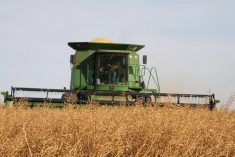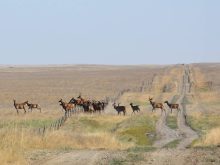Ensuring a newborn calf gets enough colostrum within its first few hours of life is critical to its survival.
Colostrum is the “first milk” produced from the cow’s mammary glands before calving. It contains antibodies, called immunoglobulins, from the maternal bloodstream. Since a calf is born without a fully developed immune system, these immunoglobulins provide the calf with temporary disease protection, known as “passive immunity.” The calf relies on this resistance until its own immune system is developed at one to two months of age.
“Colostrum contains approximately 22 percent solids, compared to 12 percent solids in normal whole cow’s milk,” says Nanita Blomquist, a beef intern with the Ag-Info Centre in Stettler, Alta.
Read Also

Bunge’s crop mix is changing
Bunge has predominantly been a soybean processing firm, but that’s about to change after the merger with Viterra with softseed processing and grain merchandising gaining ground.
“Much of this extra solid material is composed of the immunoglobulins, but also includes protein, sugar, fat, and vitamins A and E.”
A calf should drink five to six percent of its body weight in colostrum within the first six hours after birth and another five to six percent in the next six hours. For example, five to six percent of a 95 pound calf would be 5.7 pounds, or 0.6 imperial gallons.
“The calf has to drink the colostrum at birth or shortly after,” Blomquist said.
“When the calf is approximately 24 hours old, the gut lining begins to close and it cannot absorb as many of the antibodies. Studies show that at six hours after birth, calves are able to absorb 66 percent of the immunoglobulins, but at 36 hours after birth calves are able to absorb only seven percent.”
Production of colostrum starts five weeks before calving and ends at calving. A mature beef cow in good condition will produce approximately a half- gallon of colostrum. However, if the cow is leaking milk, or being nursed by other calves, it may not have enough colostrum available when it calves.
Colostrum can also be collected, frozen and used at a later date. When stripped from a cow within 24 hours of calving, it can be stored in plastic bags or containers and kept flat in the freezer in individual servings containing one to two quarts each.
Colostrum can be frozen for up to a year with no loss of quality. It can also be stored at a moderate temperature of 20 C for two days or refrigerated for one week without loss of quality. It should not be thawed and refrozen.
Colostrum needs to be thawed correctly to prevent damage, preferably by immersing it slowly in warm water.
“Submerge the sealed, frozen container in a bath of warm (less than 40 C) tap water, stirring occasionally until it is completely thawed,” Blomquist said.
“Thawing time will vary depending on container size. The colostrum should be warmed to between 40 and 43 C before feeding. It isn’t recommended that you use a microwave oven for thawing.”
Several factors affect the quality and quantity of colostrum that a cow produces, including the influence of breed and its total milk production capabilities. Large volumes of colostrum tend to have lower antibody concentrations, and dairy cattle tend to have lower antibody concentrations than beef cattle.
Younger cows that are first-and-second calvers produce less colostrum than mature animals, and the antibody concentration is lower. Older cows also have larger udders and have a quicker let-down of milk compared to young cows.
“A good management practice is to keep heifers separate from older cows to ensure the heifers get the extra nutrition they need to develop the proper amount of colostrum.”
Even so, nutrition affects the amount of colostrum produced in all cows. “Adequate protein levels in the ration are important to develop the volume, quality and antibody content required in good colostrum,” Blomquist said.
“A balanced ration including energy, protein, minerals, trace minerals and vitamins increases the immunoglobulin concentration in the colostrum.”
Producers should discuss feeding programs with a nutritionist to ensure their cows are receiving a balanced ration.














